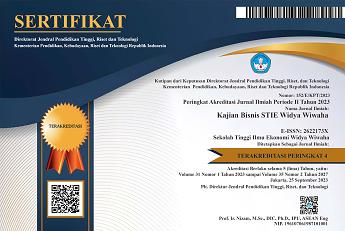PENGARUH INPUT PROSES RELATIONSHIP MARKETING TERHADAP OUTPUT PROSES RELATIONSHIP MARKETING STUDI KASUS GRAND INNA MALIOBORO HOTEL & CONVENTION
DOI:
https://doi.org/10.32477/jkb.v27i2.62Keywords:
Relationship Marketing, total quality management, customer satisfaction, customer layaltyAbstract
This research use relationship marketing teory which applied 4 factor of input process understanding customer expectations, building service partnerships, empowiring employers, and total quality management, and output relationship marketing process: customer satisfaction and customer layalty. The objective of this research is to find out wich factors of input process that has more impact on the output process in relationship marketing. There are 60 trusted correspondencea from Grand Inna Malioboro Hotel customer whom at least have been stayed at the hotel three times. The method of collecting data in these research use questioners and Likert scale measuring instrument 5 points that will be tested by the instrument and analyzed by using regressision analysi the simultaneous test of variabel for the relationship marketing input s. The result of the instrument shows the items used are valid and reliable. It displays the outpout process passed the assumtions test, while the signifikacant relationship marketingto the output of relationtionship marketing, For the passive test of vareable input process relationship marketing with the ouput process relationship marketing shows all significant variables unless vareabel understands customer expectations does not have a significant effect on the process of output relationship marketing.
References
Assel, H. (1998). Consumer Behavior and Marketing Action 6th edition. New Yoork: International Thoson Publishing.
Berry, Leonard L. And A Parasuraman (1991). Marketing Service. New Yoork: The Free Press.
Chan, Syarudin (2003). Relationship Marketing. Jakarta: Gramedia Pustaka Utama.
Engel, J. F., Blackwell, R. D. & Miniard, P. W. (1995) Perilaku konsumen. edisi keenam(terjemahan). Jakarta: Binarupa Aksara.
Evanschitzky, Heiner, Ramaseshan. B., Woisetschlager. M. David, Richelsen Verena, Blut Markus, Backhaus Christof (2011). Consequences of customer layalty tothe loyalty program company. Journal Academy of Marketing Science.
Ghozali, Imam (2011). Aplikasi Analisis Multivariate dengan Program (edisi kelima) Semarang: Universitas Diponegoro.
Griffin, J. (2003). Customer loyalty: Menumbuhkan dan mempertahankan Kesetiaan Pelanggan (Alih bahasa: Dr Dwi Kartini Yahya). Jakarta: Erlangga
Gronroos, Christian (1998). Marketing Service: The Case of Missing Product. Journal of Business & Industrial Marketing. Vol 13 No. 4/5
Gwinner et al.,1998 Olivier Morrison, Jhon W. Huppertz (2008). Jurnal External Eruty, Loyalty Program membership, and Service Recovery.
Handoko, T. H. (2001). Manajemen Personalia dan Sumberdaya Manusia. Yogyakarta: BPFE.
Kotler, P. (1997). Marketing Pemasaran, Analisis Perencanaan, Pengendalian. Jilid II. Edisi 9. Jakarta: Prehallindo
________(2000). Manajemen Pemasaran, Analisis Perencanaan, Pengendalian. Edisi Bahasa Indonesia. Jakarta; salemba 4.
Reichheld, FF. & Sasser, WE. , Jr. (1990). Zero Defections: Qualiity Comes to Service, Harvard Businness Review. September/Oktober, pp.105-111
Sugiyono (2001). Metode Penelitian Kuantitatif, Kualitatif dan R&D. Bandung: Alfabeta
Tjiptono, Fandy (2008). Strategi Pemasaran. Edisi 3, ANDI: Yogyakrta.
Zeithaml, V. A. (1988). Consumer perceptions of price, quality and value:a means-end model and sysnthesis of evidence. Jurnal of Marketing.









